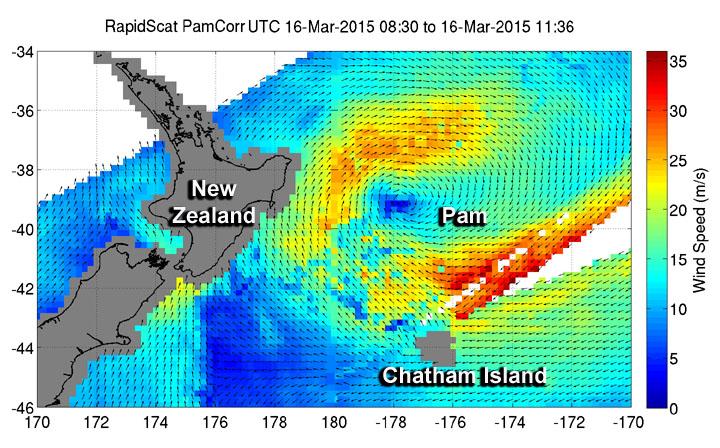RapidScat eyes Ex-Tropical Cyclone Pam's winds near Chatham Islands

RapidScat revealed sustained winds over 30 meters per second/108 kph/67 mph (in red) were still occurring southeast of Pam's center on March 16. Image Credit: NASA JPL/Doug Tyler
The International Space Station's RapidScat instrument captured data on Ex-Tropical Cyclone Pam's winds on March 16 from 08:30 to 11:36 UTC.
RapidScat revealed sustained winds over 30 meters per second (108 kph/67 mph) were still occurring southeast of the center.
The forecast calls for southwesterly winds to 50 knots (57 mph/92 kph) with high seas easing. The “easterly swell 4 meters and southwest swell rising to 7 meters. Poor visibility in heavy rain at times.
On March 17 (or 12:17 a.m. local time, March 18), the New Zealand Meteorlogical Service bulletin stated “Ex Tropical Cyclone Pam lies southeast of the Chatham Islands today, leaving a south to southwest flow over New Zealand.
A ridge moves onto New Zealand on Thursday.” For updated forecasts,visit: http://www.
Media Contact
All latest news from the category: Earth Sciences
Earth Sciences (also referred to as Geosciences), which deals with basic issues surrounding our planet, plays a vital role in the area of energy and raw materials supply.
Earth Sciences comprises subjects such as geology, geography, geological informatics, paleontology, mineralogy, petrography, crystallography, geophysics, geodesy, glaciology, cartography, photogrammetry, meteorology and seismology, early-warning systems, earthquake research and polar research.
Newest articles

Superradiant atoms could push the boundaries of how precisely time can be measured
Superradiant atoms can help us measure time more precisely than ever. In a new study, researchers from the University of Copenhagen present a new method for measuring the time interval,…

Ion thermoelectric conversion devices for near room temperature
The electrode sheet of the thermoelectric device consists of ionic hydrogel, which is sandwiched between the electrodes to form, and the Prussian blue on the electrode undergoes a redox reaction…

Zap Energy achieves 37-million-degree temperatures in a compact device
New publication reports record electron temperatures for a small-scale, sheared-flow-stabilized Z-pinch fusion device. In the nine decades since humans first produced fusion reactions, only a few fusion technologies have demonstrated…





















